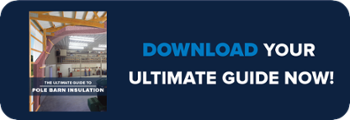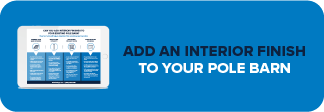Building Tips | Repairs & Renovations | Insulation
Can You Add Batt Insulation to an Existing Pole Barn?
Addy graduated from Indiana University in Indianapolis with her BFA in Graphic Design. Addy has always enjoyed being creative and now serves as a Marketing Content Creator at FBi Buildings. In her free time, she enjoys drawing, painting, photography, and spending time outside with her family and friends.
Have you ever considered a pole barn renovation? When it comes to insulation, the benefits are abundant.
Imagine a heated post-frame building, a cozy workshop, or even a living space. Along with aesthetics, you’ll also be improving energy efficiency. The process is feasible and rewarding!
In this blog, we’ll guide you through the essential steps of a successful batt insulation project.
How to Add Batt Insulation to an Existing Post-Frame Building
1) What is Batt Insulation?
Batt insulation is a cost-effective material commonly used in buildings to reduce heat transfer. These sheets or rolls are designed to fit between the framing members of walls, floors, and ceilings.
Batt insulation is mainly used to form a barrier that reduces the flow of heat between the inside and outside of a structure. It helps maintain a comfortable indoor temperature while reducing energy consumption for heating or cooling.
The material is relatively easy to install and is a popular choice for both new construction and existing structures. It’s often installed with a vapor barrier, which helps control moisture and prevent condensation within the building envelope. Common materials used for batt insulation include:
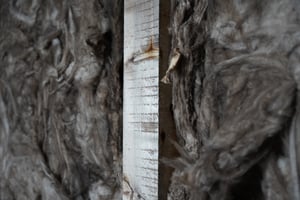
- Fiberglass: Made from fine glass fibers, fiberglass batts are lightweight and effective at insulating against heat transfer.
- Mineral Wool: This material is made from rock or slag fibers. It is known for its fire resistance and sound-absorbing properties.
- Cotton: Some batt insulation is made from recycled cotton fibers, providing an environmentally friendly option.
Pro tip: During installation, ensuring a proper fit without compressing the material is crucial, as this can reduce its effectiveness. Proper insulation is essential for energy efficiency, comfort, and overall building performance.
2) Materials & Measurements
To install batt insulation effectively, you must gather materials and take measurements carefully. Here's a general guide on what you'll need:
Materials
- Batt Insulation: Choose the appropriate type and R-value (a measure of thermal resistance) for the specific area you're insulating.
- Vapor Barrier (if needed): Some batt insulation comes with a vapor barrier facing. If not, you may need a separate vapor barrier to control moisture.
- Utility Knife: For cutting the insulation to fit around obstacles like pipes, wiring, or other protrusions.
- Tape Measure: Measure the length and width of the spaces where you plan to install the insulation.
- Safety Gear: Wear appropriate safety gear, such as gloves, long sleeves, and safety glasses, especially when handling fiberglass insulation to protect against irritation.
- Staple Gun or Insulation Supports: Depending on the installation method, you may need a staple gun to secure the insulation to the framing or insulation supports to hold it in place.
Measurements
- Length and Width of Spaces: Measure the height and width of the walls, ceilings, or floors. Make a note of any variations in dimensions.
- Depth of the Framing: Measure the depth between the framing members (studs, joists, or rafters) to determine the appropriate thickness of the insulation. Batts are often available in standard sizes to fit common framing depths.
- Obstacles and Cutouts: Identify and measure any challenges, such as electrical wiring, pipes, overhead doors, or vents, that may require cutouts in the insulation.
- Ventilation Spaces: Be aware of any spaces that need to remain open for ventilation. It's essential not to block vents with insulation.
Once you have these measurements and materials, you can cut the insulation to the appropriate size and shape, ensuring a proper fit within the framing members while addressing any obstacles or ventilation requirements.
3) Adding a Vapor Barrier
A vapor barrier is a material used to prevent moisture movement between different areas within a building. In the context of insulation, a vapor barrier is often added to control water vapor diffusion and prevent issues such as condensation within the building. Here's some information on adding a vapor barrier along with insulation, especially with batt insulation:
When to Use a Vapor Barrier
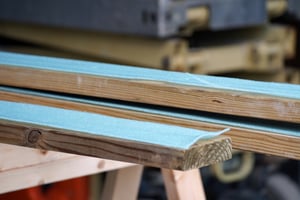
- Cold Climates: In regions where the exterior is colder than the interior, a vapor barrier is typically installed on the warm side of the insulation to prevent moisture from entering the wall or ceiling cavity.
- Air Conditioning: In climates where air conditioning is common, a vapor barrier is often installed on the interior side of walls to prevent humid indoor air from reaching the colder wall surfaces.
Types of Vapor Barriers
- Faced Insulation: Some batt insulation comes with a built-in vapor barrier. Often made of kraft paper or foil, the facing is a barrier against moisture. Ensure the facing is installed on the warm side (the interior in cold climates, the exterior in hot climates).
- Separate Vapor Barrier: In situations where the insulation doesn't have a facing, a separate vapor barrier, a plastic sheeting can be installed. This is usually applied on the warm side of the insulation and should be sealed at seams and edges to create an effective barrier.
Installation Tips
- Proper Placement: The vapor barrier should be placed on the side of the insulation facing the warm, humid interior. For walls, it's typically installed on the interior side; for ceilings, it's often on the warm side.
- Sealing: Ensure that the seams and edges of the vapor barrier are properly sealed to prevent air leakage. Use appropriate tapes or adhesives designed for this purpose.
- Around Obstacles: When installing a vapor barrier with batt insulation, carefully cut and fit the material around obstacles like electrical boxes, wiring, and other penetrations.
Considerations
- Climate Zone: Building codes may specify using vapor barriers based on climate zones. Check local building codes to determine the requirements for your area.
- Moisture Sources: Consider potential moisture sources within the building, such as bathrooms or kitchens, and plan the vapor barrier placement accordingly.
Adding a vapor barrier is an important step in moisture control. It can contribute to the overall energy efficiency and durability of a building. Always follow manufacturer recommendations and local building codes when installing insulation and vapor barriers.
4) Installing Batt Insulation
Once you’ve installed the vapor barrier and prepared the space, hanging batt insulation comes next. Here's a step-by-step guide:
Measure and Cut
- Measure the space between the framing members (studs or joists) where you plan to install the insulation.
- Use a utility knife, insulation cutter, and a straightedge to cut the insulation to the required size.
Install the Insulation
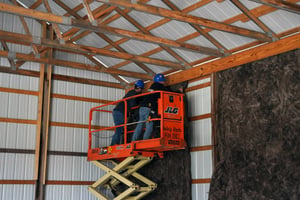
- Place the cut insulation into the cavity between the framing members.
- Ensure a snug fit without compressing the insulation, or else it’ll reduce its effectiveness.
Secure with Staples
- Use a staple gun to secure the insulation to the framing members—staple at regular intervals along the edges and at the center.
Repeat for Each Section
- Repeat the process for each wall, floor, or ceiling section that requires insulation.
Are You Ready to Add Batt Insulation to Your Existing Building?
At FBi Buildings, our Repair & Renovation Specialists will help you navigate the building process to get the best bang for your buck.
We’ll also tell you a secret: it doesn’t matter who built the original pole barn. We’ll repair or renovate ANY post-frame building!
Are you ready to get started on your pole barn addition? Please call our office at (800) 552-2981, and we’ll gladly give you a FREE renovation quote.
Do you have more questions that aren’t covered in this article? If you need help designing and planning, please contact FBi Buildings at 800.552.2981 or click here to email us. If you’re ready for a price, click here to request a quote, and a member of our Customer Engagement Team will help you determine the next steps.



